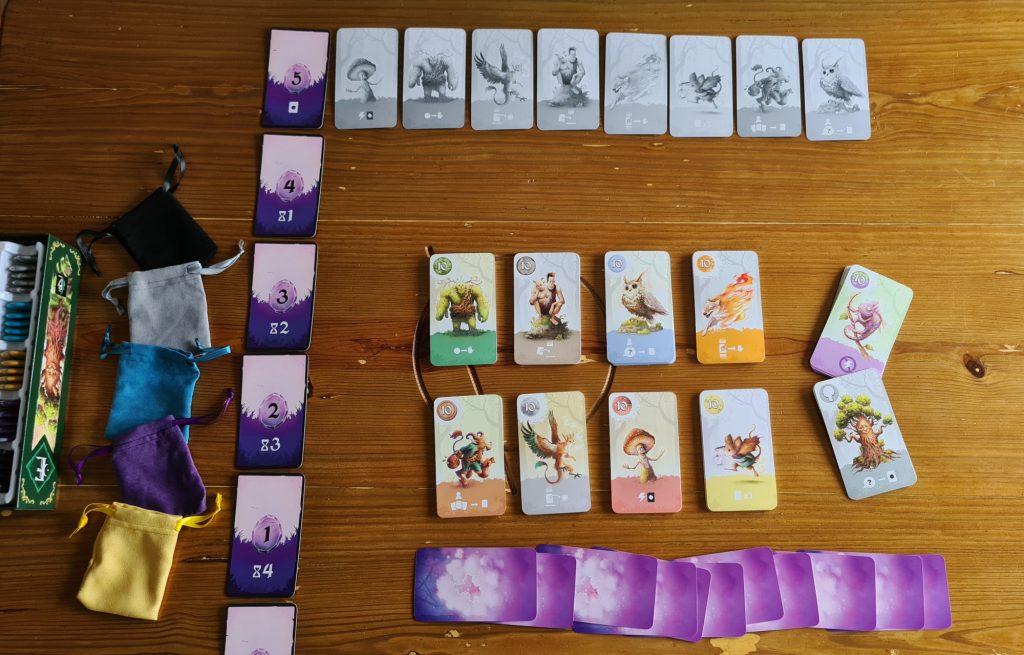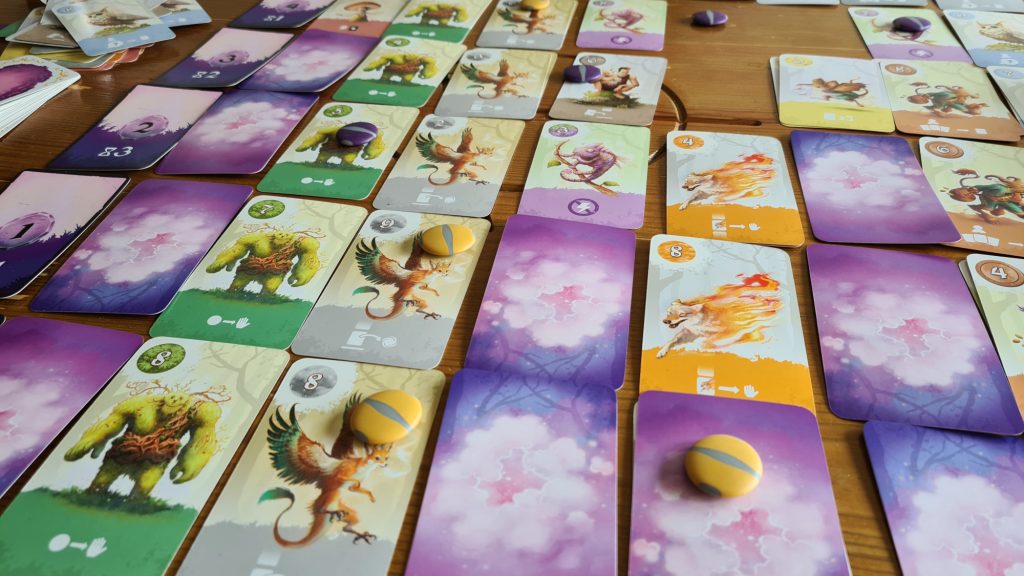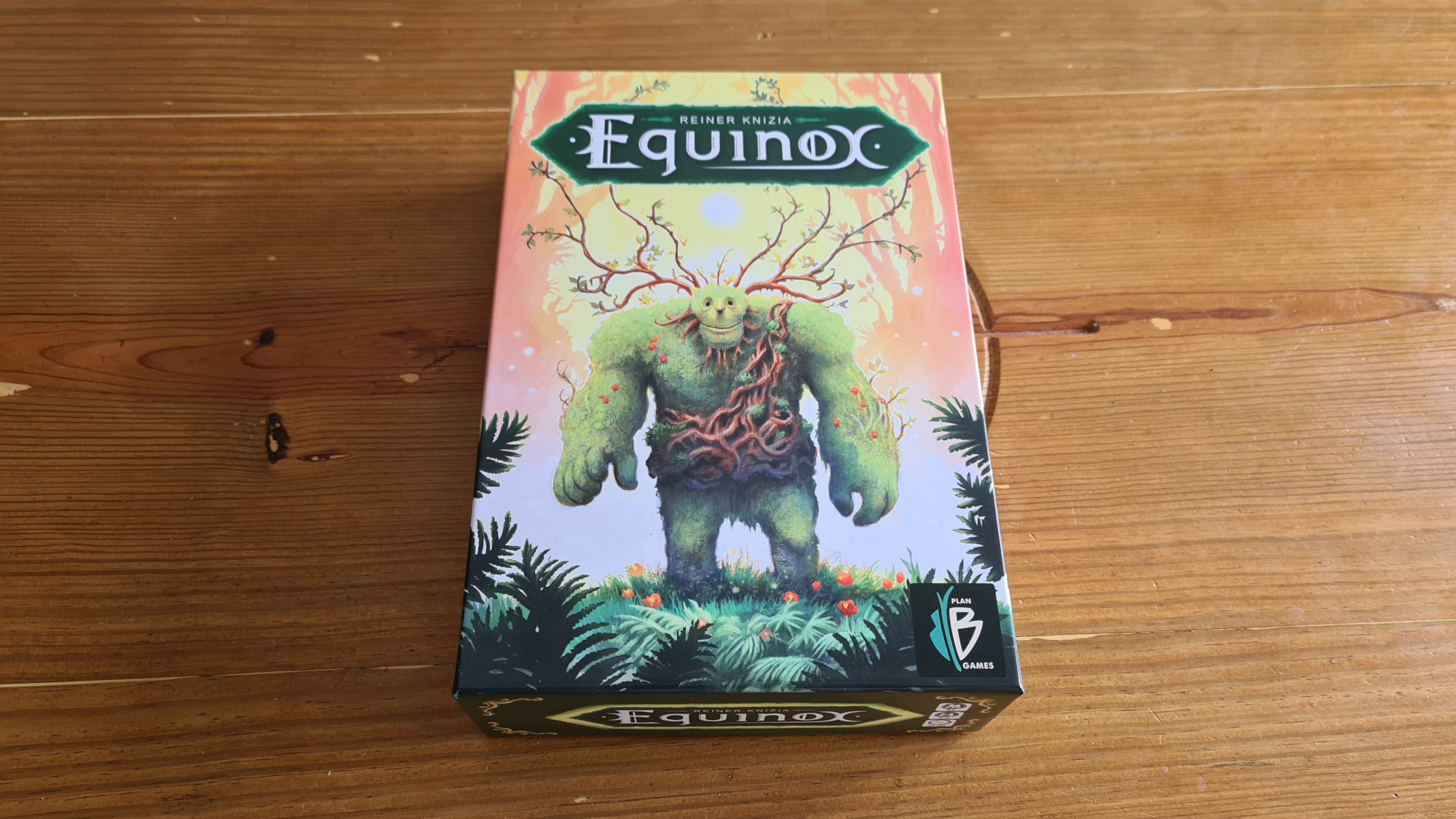Equinox is the brand new release from Plan B Games, about which legendary creatures will survive. Designed by Reiner Knizia, featuring artwork from Chris Quilliams, the game combines betting and hand management, with gamers playing cards to influence the outcome of the rounds. Playing in around 45 minutes, this reimplementation of Knizia’s Colossal Arena sees 2 – 5 players use public and secret bets in their attempt to control creatures and ultimately win! However, is this a legendary experience? Let’s find out!
(Editor’s Note: There are two box covers for Equinox. The components within the two versions are identical.)
At the start of the game 8 of the 14 creatures are randomly chosen. Laid out along the top of a grid the round cards are placed down the side. The 11 cards of each creature, which have strength values of 0 – 10, are all shuffled together with chameleons and tree cards. From this huge deck of cards each player is dealt 8 cards to be their starting hand. Players choose a colour and take the small bag and bidding pebbles in that colour. The game then starts with the starting player being whoever’s birthday is closest to an equinox.
On your turn you will go through 5 phases: bidding, playing a card, discarding, drawing back up to 8 cards and finally checking to see if the round is over. Players have 5 bidding pebbles to use across the entire game, with this phase commonly skipped. Regular bids see the player place one of their unspent pebbles onto a pebble free grid space of an in play creature – be that in the gap where a card will be played that round or onto a card already played that round.
Bids can score points at the end of the game if the creature is still in play, with the amount depending on how early in the game the bid was made. Bidding like this also helps a player control a creature – which is important for when playing a card. During the first round players can also make a secret bid by playing a card from their hand face down off to the side of the grid and placing a pebble on it. Their bid is hidden from the others until they decide to reveal it later – which is done to gain control of a creature.

The next phase sees a player choose one card from their hand and placing it into the row of the current round. If a card of that creature type has already been played that round the new one is placed on top, with the top most card being the only visible one. The visible cards, not those hidden below, determine the strength of the creatures. When playing a card of a creature that you control, via the bidding pebbles, you can also trigger its ability. These abilities range from drawing additional cards to taking a card from the grid into your hand.
At this stage the player can discard up to three cards from their hand that feature disappeared creatures, before drawing back up to a hand of 8 cards. There won’t be any in the first round, as all creatures are in play. At the end of each player’s turn a check needs to be made, after each creature has a card played in a round. If one of the creatures has the lowest strength – not being triggered if two are equally lowest – it is eliminated and a new round begins. If this doesn’t occur play continues with the next player clockwise around the table.
At the end of Equinox three creatures will remain, with the rest eliminated. To help players keep track of this disappeared cards are used, with the final disappeared card simply placed over the top of the last to be eliminated creature. Points are then earnt based upon players’ correct bets. Secret bets are worth 5 prestige points (revealed or not), with bets made in the first round worth 4 points – reduced by a point each round. Whoever has the most prestige points wins, with ties broken by correct secret predictions.

A lot of Equinox’s variety comes from the elements during setup. 6 of the 14 creatures are returned to the box – with their abilities not seen within the game. Playing a game with the same creatures can be varied, simply from the shuffling of the deck and the way players choose to bid and play the cards. Having the ability to swap out nearly all of the cards from one game to the next helps maintain the fresh feeling, when playing back to back games. It’s very easy to have favourite creatures, due to their abilities. Stopping players becoming too reliant on their favourite is therefore easy to do, by shuffling specific creatures out at the start.
While players cannot combine these powers on an individual turn they can still use them across multiple turns to great effect. For example, a player could bluff a bet on an animal in one round, only to then play a low strength card and utilize the Moss Man’s power to remove their bid token. There are ways to interrupt the powers of the creatures others control. Chameleons can be played into any creature row, coming with their own strength value. These don’t trigger the associated creature’s ability and they even stop the next use too.
A good 5+ minutes of Equinox’s game length can be attributed to setup and teardown. Due to the way differing creatures can be used from one game to the next the deck cannot be left shuffled. This means at the start of the game someone has to shuffle the piles of 8 creatures, a handful of special cards and the chameleons. This isn’t overly easy either, with this combined deck being over 100 cards tall. At the end of the game players then need to split out the creatures again, else the setup of the next game would be rather painful.

With the amount the cards are shuffled and handled it’s great to see that the card quality in Equinox is high. The artwork that adorns them makes each weird and wonderful creature distinctive. The iconography becomes helpful after a game or so to remember the powers without looking them up. Most are intuitive but a few just took that first game or two to click. The stand out components are the vibrantly coloured and chunky bidding pebbles. One odd inclusion though are the cloth bags to put the pebbles in, it’s not like the amount players have is ever secret. Players start with 5 and you can see how many they have played, making the bags basically pointless, as they don’t even store the pebbles in the box.
Equinox takes a game or two to get into but when not needing to quickly look up abilities the game flows, with interesting choices to make on each turn. The artwork makes the game stand out, with the grid dominating a table, and then the glorious pebbles get placed. The abilities that make learning a little more complex make the game what it is. Without them playing cards and bidding would quickly become samey. Instead, there are combos and chances for bigger than normal turns to look forward to. There is variety straight out of the box from the 14 creature types and those that enjoy the bidding and bluffing gameplay will have a game that will stay fresh for many plays to come.
(Editor’s Note: Equinox was provided to us by Asmodee for the review. The game is currently available from local board game stores! Find your local store here.)

